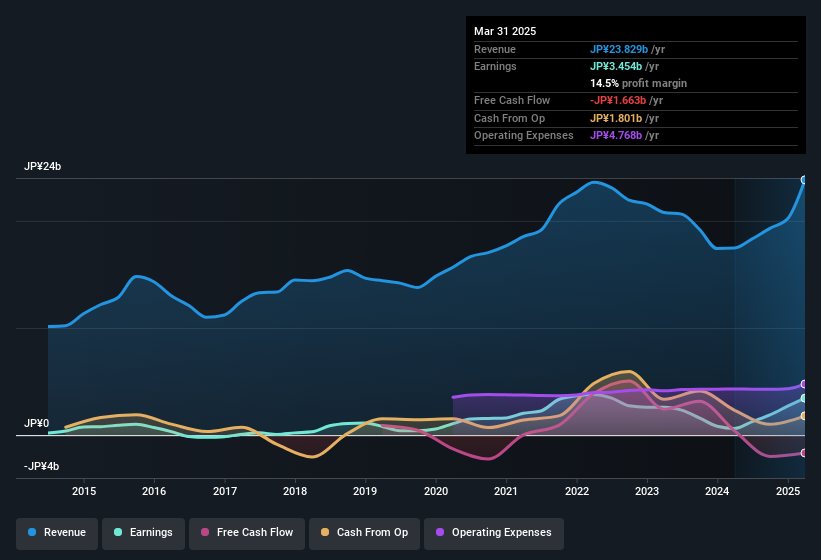- Japan
- /
- Semiconductors
- /
- TSE:6855
Japan Electronic Materials' (TSE:6855) Promising Earnings May Rest On Soft Foundations

Despite posting some strong earnings, the market for Japan Electronic Materials Corporation's (TSE:6855) stock hasn't moved much. Our analysis suggests that this might be because shareholders have noticed some concerning underlying factors.
Our free stock report includes 3 warning signs investors should be aware of before investing in Japan Electronic Materials. Read for free now.
A Closer Look At Japan Electronic Materials' Earnings
One key financial ratio used to measure how well a company converts its profit to free cash flow (FCF) is the accrual ratio. To get the accrual ratio we first subtract FCF from profit for a period, and then divide that number by the average operating assets for the period. The ratio shows us how much a company's profit exceeds its FCF.
As a result, a negative accrual ratio is a positive for the company, and a positive accrual ratio is a negative. While having an accrual ratio above zero is of little concern, we do think it's worth noting when a company has a relatively high accrual ratio. To quote a 2014 paper by Lewellen and Resutek, "firms with higher accruals tend to be less profitable in the future".
Japan Electronic Materials has an accrual ratio of 0.27 for the year to March 2025. Therefore, we know that it's free cashflow was significantly lower than its statutory profit, which is hardly a good thing. Over the last year it actually had negative free cash flow of JP¥1.7b, in contrast to the aforementioned profit of JP¥3.45b. We saw that FCF was JP¥397m a year ago though, so Japan Electronic Materials has at least been able to generate positive FCF in the past.
That might leave you wondering what analysts are forecasting in terms of future profitability. Luckily, you can click here to see an interactive graph depicting future profitability, based on their estimates.
Our Take On Japan Electronic Materials' Profit Performance
Japan Electronic Materials didn't convert much of its profit to free cash flow in the last year, which some investors may consider rather suboptimal. Therefore, it seems possible to us that Japan Electronic Materials' true underlying earnings power is actually less than its statutory profit. But the happy news is that, while acknowledging we have to look beyond the statutory numbers, those numbers are still improving, with EPS growing at a very high rate over the last year. At the end of the day, it's essential to consider more than just the factors above, if you want to understand the company properly. If you'd like to know more about Japan Electronic Materials as a business, it's important to be aware of any risks it's facing. Be aware that Japan Electronic Materials is showing 3 warning signs in our investment analysis and 2 of those are a bit unpleasant...
This note has only looked at a single factor that sheds light on the nature of Japan Electronic Materials' profit. But there is always more to discover if you are capable of focussing your mind on minutiae. Some people consider a high return on equity to be a good sign of a quality business. So you may wish to see this free collection of companies boasting high return on equity, or this list of stocks with high insider ownership.
New: Manage All Your Stock Portfolios in One Place
We've created the ultimate portfolio companion for stock investors, and it's free.
• Connect an unlimited number of Portfolios and see your total in one currency
• Be alerted to new Warning Signs or Risks via email or mobile
• Track the Fair Value of your stocks
Have feedback on this article? Concerned about the content? Get in touch with us directly. Alternatively, email editorial-team (at) simplywallst.com.
This article by Simply Wall St is general in nature. We provide commentary based on historical data and analyst forecasts only using an unbiased methodology and our articles are not intended to be financial advice. It does not constitute a recommendation to buy or sell any stock, and does not take account of your objectives, or your financial situation. We aim to bring you long-term focused analysis driven by fundamental data. Note that our analysis may not factor in the latest price-sensitive company announcements or qualitative material. Simply Wall St has no position in any stocks mentioned.
About TSE:6855
Japan Electronic Materials
Engages in the manufacture and sale of probe cards and electron tube parts in Japan and internationally.
Flawless balance sheet and undervalued.
Similar Companies
Market Insights
Community Narratives




